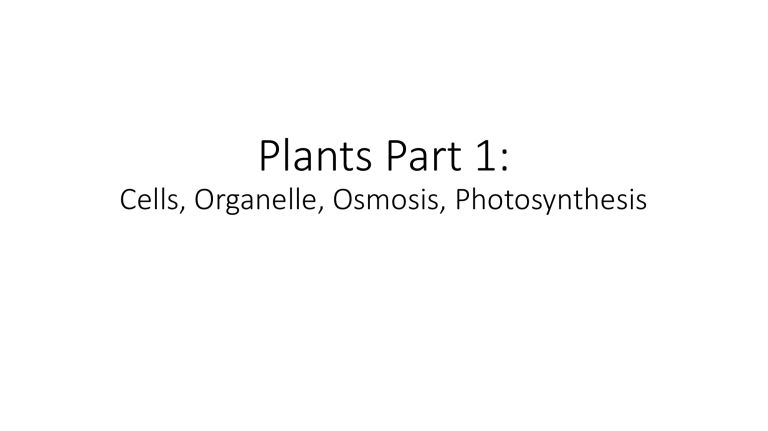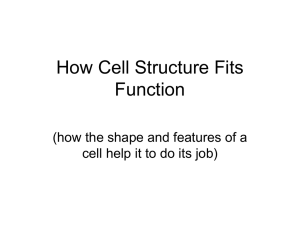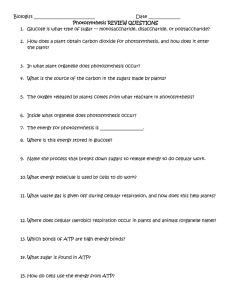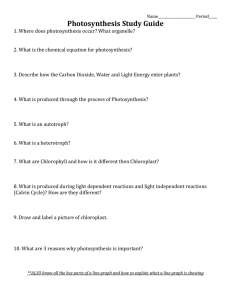Plants

Plants Part 1:
Cells, Organelle, Osmosis, Photosynthesis
Taxonomy: Categorizing living things into groups based on similarities
6 kingdoms:
1. Eubacteria: bacteria
2. Archaebacteria: extreme bacteria
3. Protista: seaweed and singlecelled critters, can be plant or animal-like
4. Animalia: animals, no cellwalls, heterotrophs (must eat)
5. Fungi: fungus, cell walls and heterotrophs
6. Plantae: plants
Plants: multicellular organisms that are sessile , produce their own food from inorganic matter by the process of photosynthesis and have rigid cell walls
– Multicellular: contains more than one cell
– Sessile: doesn’t move under its own power
– Inorganic matter: not alive, CO
2
, H
2
O
– Photosynthesis: Produces glucose sugar from sunlight, CO
2
– Cell Walls: surround the cell and give it shape and H
2
O
Plants Do NOT Include:
1. Algae (live in water, single celled, and has no roots = Protist)
2. Seaweed (lives in water, no roots = Protist)
3. Fungi (consumes dead organisms, no photosynthesis)
4. Bacteria (unicellular)
5. Animals (no photosynthesis, can move)
• Some plants live in water or don’t photosynthesize (parasites). They are considered plants because they are descended from legitimate photosynthesizing, land-dwelling plants
Plant Cells and Animal Cells contain organelle
• Organelle: parts of a cell
• All living things are made of cells that are surrounded by a cell membrane, which keeps the inside separated from the outside and allows certain molecules through.
• Plants and animals are both eukaryotes (DNA is enclosed in a nucleus)
• The cytoplasm is everything between the cell membrane and the nucleus. It holds the organelle and does chemical changes needed to keep the cell alive.
• Both have mitochondria that produce ATP energy for the cell.
Plant Cells vs. Animal Cells
• Plant cells are different from animal cells in several ways:
• Rigid cell wall that is OUTSIDE the cell membrane. It is the box that contains the cell.
• Central vacuole that stores water
• Chloroplasts that perform photosynthesis
- Chloroplasts were originally freeliving photosynthetic bacteria that got swallowed by a primitive eukaryotic cell and developed a beneficial symbiotic relationship inside the cell
(endosymbiont theory)
Cell Walls:
• The cell wall is mostly made of cellulose.
• Cellulose is a molecule made of many glucose sugar molecules linked in long chains
• Starch is also made of many glucose units, but the connection between the glucoses is different.
• Almost all organisms can easily digest starch, but only bacteria and protists can digest cellulose.
Glucose
Sugar
Osmosis:
• All cells have to deal with osmosis:
• Water moves from areas of high water concentration (lots of water molecules and less salt) to areas of low water concentration
(more salt and less water).
What happens in different solutions?
• Hypertonic:
High water concentration inside the cell
• Isotonic: equal inside and out
• Hypotonic:
High water concentration outside the cell
Water leaves, cell shrinks Water leaves and enters, cell stays the same
Water enters, cell expands
What is the purpose of cell walls?
• There is usually a higher concentration of salt particles inside the cell
• So water moves into the cell, which would cause the cell to swell and burst.
• The cell wall acts as a box to prevent the cell from bursting.
Why do plants wilt?
• If the plant isn’t getting enough water (or if the plant is put in a high salt solution), the water supply in the central vacuole moves into the cytoplasm.
• This causes the cell to shrink away from the cell wall.
• The plant wilts
Photosynthesis:
• The plant takes in:
1. Light energy from the sun
2. Carbon dioxide (CO
2
) from the air
3. Water (H
2
O) from the soil
• The plant produces:
1. Oxygen gas (O
2
)
2. Sugar (C
6
H
12
O
6
)
• Photosynthesis happens in the chloroplasts.





